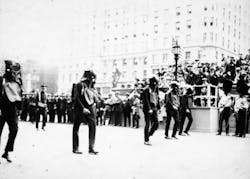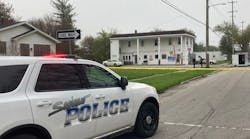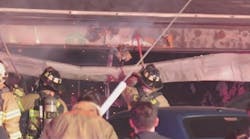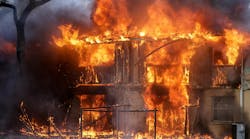NEW YORK CITY: JUNE 3, 1915 – A 14-year-old boy named Joseph Batewell, living at 8 Broome St. in Manhattan, was starting to school when he heard the cries of a neighbor’s child. Seeing a red glow reflected in the window over the apartment door and hearing the young girl pounding on the locked door, Joseph raced through the adjoining flat and across the fire escape and entered the apartment. There he found 8-year-old Mary with her clothes ablaze, ignited by an overturned kerosene lamp. Joseph caught the girl in his arms and put the fire out. Seeing the girl was now safe, he left her with her mother, and hurried off to school worried he would be late.
PENDLETON, OR: JUNE 4, 1915 – Flames broke out in the old Bailey Building at Water and Main streets, one of the last frame buildings in the business district. The three-story building—a former post office, stage office and town hall—was erected in 1878. Plans to renovate the structure were abandoned and the property sold. The building was completely destroyed.
THOMASTON, ME: JUNE 6, 1915 – Flames ignited in a stable within the Watts Block and was soon blazing out of control. The stable’s owner believed the fire was intentionally set. The fire swept four stores in the mercantile block then spread to The Knox House, the only hotel in town. The entire block was left a smoldering ruin.
LITTLE FERRY, NJ: JUNE 7, 1915 – The town’s mayor, Frank Herma, was credited with rescuing two small children from a house fire. The blaze started when an oil lamp was knocked over. The unconscious children were pulled from the smoky blaze and revived by neighbors. The house was partially saved by the dogged work of local firemen.
BALTIMORE, MD: JUNE 8, 1915 – While on driver’s practice, Assistant Engineman August Myers was operating the Christie tractor attached to a reserve engine. While driving on the Gilford Avenue Bridge, he lost control of the rig. The steamer jumped the curb, crashed through a guardrail and plunged 50 feet. A helper onboard was able to jump clear, but the driver was gravely injured, losing both his legs. After months of painful recovery, he left the hospital and spent the next 42 years in retirement.
PRINCETON, NJ: JUNE 11, 1915 – A fire broke out in a large stable behind the Nassau Inn. Princeton students helped the responding volunteer firemen battle the growing blaze. Several horses were pulled from the blazing stable only to bolt back inside. In all, three large wooden buildings and 17 horses were lost to the flames.
NEW YORK, NY: JUNE 12, 1915 – The FDNY marked its 50-Year Anniversary with a huge parade and demonstration. The line of march featured firefighting relics, such as the original 1725 hand pumper shipped from England by their maker, Richard Newsham. A large contingent of exempt volunteer firemen and their equipment also paraded. As the parade passed, the equipment and firefighters became more modern with hand-drawn rigs giving way to horse-drawn rigs, only to be followed by new motorized apparatus. A group of firemen from the newly formed Rescue Company marched wearing smoke helmets. At the conclusion of the parade, the department assembled for a demonstration of tactics and gear. Mayor Mitchel and Chief Kenlon then presented eight members of the department with medals for valor.
DORNOCH, SCOTLAND: JUNE 13, 1915 – Dunrobin Castle, the Highland residence of the Duke of Sutherland, was partially destroyed by flames. The castle, which was being utilized as a hospital for wounded soldiers, was of modern construction while incorporating parts of the ancient fortress built back in 1097. All wounded soldiers were safely evacuated.
WEST ORANGE, NJ: JUNE 20, 1915 – Profiting from the experience of firemen battling a $3 million fire in Edison Works on Dec. 9, 1914, Thomas Edison perfected a new invention he tested as darkness fell. Edison and his son, Charles, rolled out their new 3-million candlepower searchlight. This battery-powered device, the most powerful portable light ever built, immediately scared people across the valley who called police after seeing a huge shaft of light several miles high in the sky. Edison conceived of the idea after watching firemen battle the fire in his plant in total darkness. It was believed the light would be useful in mine rescues, fires and other emergencies.






